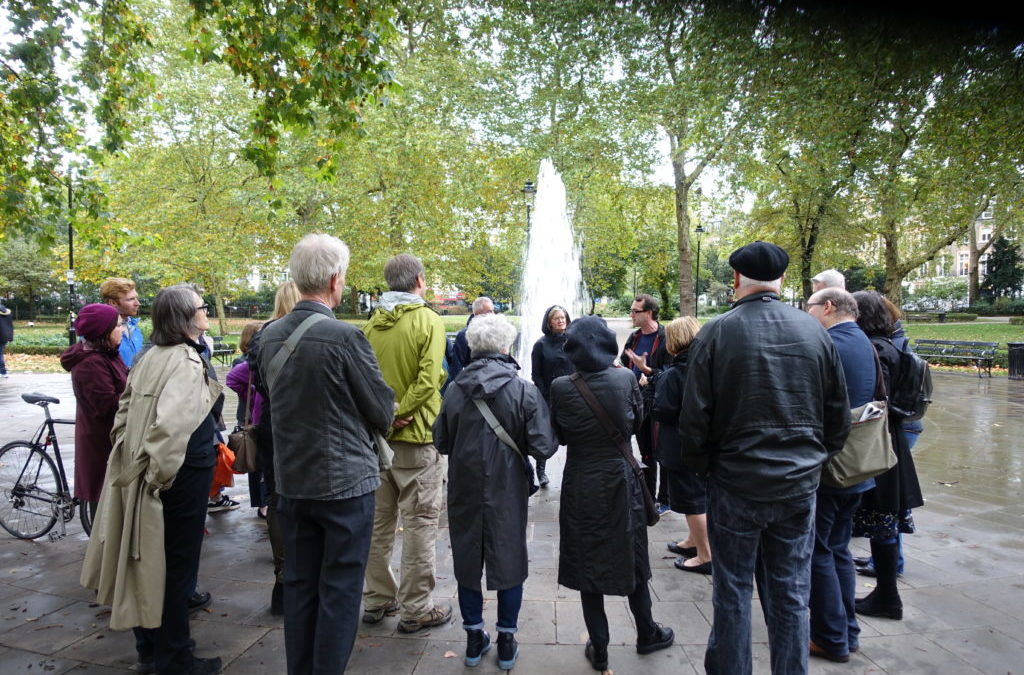On Saturday 22 September, the IHR hosted a walking tour of ‘Suffrage and radical Bloomsbury’. The event formed part of the Institute’s year-long ‘Suffrage Series, 1918-2018’ devised to mark the centenary of the Representation of the People Act, 1918. The series culminates with a suffragette concert and the annual Kehoe lecture in November 2018.
We were not the first group of radically-minded men and women to gather in the centre of Russell Square. On 10 April 1848, thousands of Chartists had also congregated here ahead the movement’s largest-ever march to Kennington Common. 170 years later, on a Saturday in late September, a more select group of 30 history enthusiasts met at the same location. Our purpose was to follow in the footsteps of some of the many campaigners, reformers and radicals who once lived and worked in the Bloomsbury area of central London.
The IHR’s ‘Suffrage Bloomsbury’ walking tour — part of the Institute’s ‘Suffrage series, 1918-2018’ — was devised and led by Dr Matthew Ingleby of Queen Mary, University of London, whose research focuses on the history of Bloomsbury and its construction in nineteenth-century fiction.

From Russell Square we walked to Cartwright Gardens, passing en route the site of the former home of Emmeline Pankhurst, on which now stands the Russell Hotel. The gardens (1809-11) are named for the local resident, John Cartwright (1740-1824), who was a noted campaigner for universal suffrage and annual parliaments. An interest in political association led Cartwright to establish the Society for Constitutional Information (1780) whose membership championed the ideas of Thomas Paine. The statue of Cartwright, around which the group gathered, was erected in 1831.


Then it was on to neighbouring Tavistock Square and another statue.

Mohandas Gandhi (1869-1948) was resident in London for three years from 1888, where he studied law at University College London and the Inner Temple, and was called to the Bar. His statue in Tavistock Square (installed in 1968) recalls Bloomsbury’s close association with the cause of Indian Independence, and as a place of residence for late-nineteeth and twentieth-century Indian visiting students. The area is also home, since 1920, to The Indian Students’ Union and Hostel, where many hundreds of students settled on their arrival in the capital, and which is now located at 41 Fitzroy Square.

A few hundred metres from Tavistock Square we stopped next at the gates of University College London which has a long association with reform, not least for its status as a non-denominational institution. From 1878, UCL was also the first British college to admit women students on equal terms to their male counterparts in all subjects other than medicine.
In the same year, London became the first UK university to admit women to its degree programme, while the following decade saw the establishment of two dedicated colleges of women’s higher education — Westfield (in 1882) and Royal Holloway (1886) — which in turn became part of the wider university. By 1895, 10 per cent of London undergraduates were women, rising to 30 per cent within five years.

En route to our final stop, the group paused outside the British Museum whose Reading Rooms provided intellectual stimulus (and warmth) to many more radicals aside from its best-known resident, Karl Marx. These included his daughter Eleanor Marx (1855-1898), her friend the Trade unionist Clementina Black (1853-1922) and the Bloomsbury bohemian poet Amy Levy (1861-1889)for whom the Museum became the focus of a late nineteenth-century literary community.

The walking tour’s final destination was St George’s Church, Bloomsbury where, on 14 June 1913, the funeral was held for the suffragette Emily Wilding Davison (1872-1913). Davison, a former Royal Holloway student, was by the early 1910s a noted activist in the Women’s Social and Political Union campaign for suffrage reform. On 4 June Davison had thrown herself before the king’s horse at the Epsom Derby, sustaining injuries from which she died soon after. Her funeral and the subsequent procession became one of the most important events of the suffragette movement, watched in the streets by as many as 50,000 spectators.
Following the funeral service the procession, led by prominent WSPU members and former prisoners, moved slowly and noisily to King’s Cross station where Davison’s coffin travelled to her home town of Morpeth, Northumberland, for burial. The IHR tour ended, as on 14 June 1913, with a singing of the suffragette anthem, ‘March of the Women’, composed by Davison’s fellow WSPU member, Ethel Smyth.


Emily Wilding Davison’s funeral, St George’s Bloomsbury, 14 June 1914, (c) LSE Library via Flickr

Dr Matthew Ingleby is lecturer in Victorian literature at Queen Mary, University of London. A specialist in the history and literature of Bloomsbury, his publications include Bloomsbury. Beyond the Establishment (British Library, 2017), Nineteenth-Century Fiction and the Production of Bloomsbury: Novel Grounds (Palgrave, 2018) and a co-edited collection, Coastal Cultures of the Long Nineteenth Century (Edinburgh UP, 2018).
For details of other walking tours, talks and essays see Matt’s blog www.victorianeveryday.org or @matthewingleby.
Forthcoming events in the IHR’s ‘Suffrage series, 1918-2018’

The IHR’s ‘Suffrage Season, 1918-2018’ continues with ‘Songs of Suffrage: an evening of music and readings, 1900-1930’ on Thursday 1 November 2018. This evening concert features the chamber works of three suffrage composers, Ethel Smyth, Rebecca Clarke and Dorothy Howell, performed by members of the Berkeley Ensemble and the BBC broadcaster and music historian, Dr Kate Kennedy.
A centre piece to the concert will a performance of Dorothy Howell’s string quartet, first played in 1919 and then ‘lost’. Howell, Clarke and Smyth were each supporters of the suffrage movement, with Ethel Smyth a prominent member of Women’s Social and Political Union, and composer of the suffragette anthem ‘March of the Women’.

The IHR’s suffrage season concludes on Thursday 15 November with the 2018 Kehoe Lecture in Irish History, given this year by Professor Senia Paseta of Oxford University. Professor Paseta will speak on ‘Suffrage and Citizenship in Ireland, 1912-1918’

